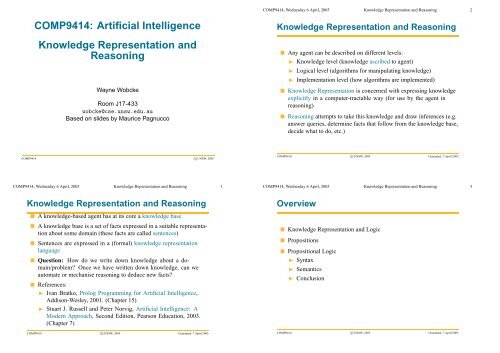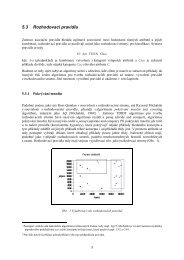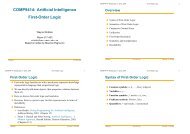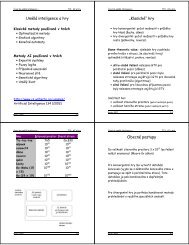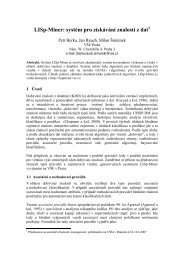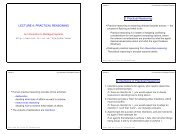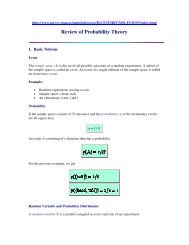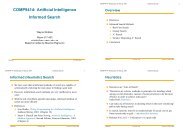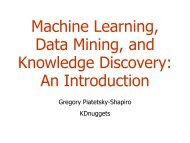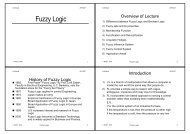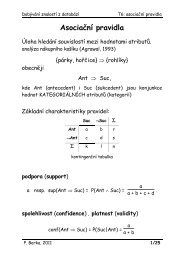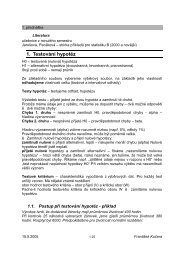COMP9414: Artificial Intelligence Knowledge Representation ... - Sorry
COMP9414: Artificial Intelligence Knowledge Representation ... - Sorry
COMP9414: Artificial Intelligence Knowledge Representation ... - Sorry
You also want an ePaper? Increase the reach of your titles
YUMPU automatically turns print PDFs into web optimized ePapers that Google loves.
<strong>COMP9414</strong>, Wednesday 6 April, 2005 <strong>Knowledge</strong> <strong>Representation</strong> and Reasoning 2<br />
<strong>COMP9414</strong>: <strong>Artificial</strong> <strong>Intelligence</strong><br />
<strong>Knowledge</strong> <strong>Representation</strong> and<br />
Reasoning<br />
Wayne Wobcke<br />
Room J17-433<br />
wobcke@cse.unsw.edu.au<br />
Based on slides by Maurice Pagnucco<br />
<strong>Knowledge</strong> <strong>Representation</strong> and Reasoning<br />
Any agent can be described on different levels:<br />
◮ <strong>Knowledge</strong> level (knowledge ascribed to agent)<br />
◮ Logical level (algorithms for manipulating knowledge)<br />
◮ Implementation level (how algorithms are implemented)<br />
<strong>Knowledge</strong> <strong>Representation</strong> is concerned with expressing knowledge<br />
explicitly in a computer-tractable way (for use by the agent in<br />
reasoning)<br />
Reasoning attempts to take this knowledge and draw inferences (e.g.<br />
answer queries, determine facts that follow from the knowledge base,<br />
decide what to do, etc.)<br />
<strong>COMP9414</strong> c○UNSW, 2005<br />
<strong>COMP9414</strong> c○UNSW, 2005 Generated: 7 April 2005<br />
<strong>COMP9414</strong>, Wednesday 6 April, 2005 <strong>Knowledge</strong> <strong>Representation</strong> and Reasoning 1<br />
<strong>COMP9414</strong>, Wednesday 6 April, 2005 <strong>Knowledge</strong> <strong>Representation</strong> and Reasoning 3<br />
<strong>Knowledge</strong> <strong>Representation</strong> and Reasoning<br />
A knowledge-based agent has at its core a knowledge base<br />
A knowledge base is a set of facts expressed in a suitable representation<br />
about some domain (these facts are called sentences)<br />
Sentences are expressed in a (formal) knowledge representation<br />
language<br />
Question: How do we write down knowledge about a domain/problem?<br />
Once we have written down knowledge, can we<br />
automate or mechanise reasoning to deduce new facts?<br />
References:<br />
◮ Ivan Bratko, Prolog Programming for <strong>Artificial</strong> <strong>Intelligence</strong>,<br />
Addison-Wesley, 2001. (Chapter 15)<br />
◮ Stuart J. Russell and Peter Norvig, <strong>Artificial</strong> <strong>Intelligence</strong>: A<br />
Modern Approach, Second Edition, Pearson Education, 2003.<br />
(Chapter 7)<br />
<strong>COMP9414</strong> c○UNSW, 2005 Generated: 7 April 2005<br />
Overview<br />
<strong>Knowledge</strong> <strong>Representation</strong> and Logic<br />
Propositions<br />
Propositional Logic<br />
◮ Syntax<br />
◮ Semantics<br />
◮ Conclusion<br />
<strong>COMP9414</strong> c○UNSW, 2005 Generated: 7 April 2005
<strong>COMP9414</strong>, Wednesday 6 April, 2005 <strong>Knowledge</strong> <strong>Representation</strong> and Reasoning 4<br />
Why do we need formal languages?<br />
Consider an English sentence like:<br />
“The boy saw a girl with a telescope”<br />
Also:<br />
“Our shoes are guaranteed to give you a fit” (lexical ambiguity)<br />
“I heard about him at school” (structural ambiguity)<br />
“As he uttered the all-important word he dropped his voice, but<br />
she just managed to catch it” (ambiguity of cross reference)<br />
Natural languages exhibit ambiguity<br />
Not only does ambiguity make it difficult for us to understand what is<br />
the intended meaning of certain phrases and sentences but also makes<br />
it very difficult to make inferences<br />
Symbolic logic is a syntactically unambigious knowledge representation<br />
language (originally developed in an attempt to formalize<br />
mathematical reasoning)<br />
<strong>COMP9414</strong> c○UNSW, 2005 Generated: 7 April 2005<br />
<strong>COMP9414</strong>, Wednesday 6 April, 2005 <strong>Knowledge</strong> <strong>Representation</strong> and Reasoning 6<br />
Propositions<br />
Propositions are entities (facts or non-facts) that can be true or false<br />
Propositions are expressed using ordinary declarative sentences<br />
◮ e.g. the sentence “The sky is blue” expresses the proposition that<br />
the sky is blue. Is this proposition true?<br />
Other propositions:<br />
“Socrates is bald” (assume ‘Socrates’, ‘bald’ are well defined)<br />
“The car is red” (assume ‘the car’ is identified)<br />
“Socrates is bald and the car is red” (complex proposition)<br />
Often use single letters to represent propositions in reasoning:<br />
P: Socrates is bald<br />
(reasoning is independent of propositional substructure!)<br />
This is referred to as a scheme of abbreviation<br />
<strong>COMP9414</strong> c○UNSW, 2005 Generated: 7 April 2005<br />
<strong>COMP9414</strong>, Wednesday 6 April, 2005 <strong>Knowledge</strong> <strong>Representation</strong> and Reasoning 5<br />
Syntax vs. Semantics<br />
<strong>COMP9414</strong>, Wednesday 6 April, 2005 <strong>Knowledge</strong> <strong>Representation</strong> and Reasoning 7<br />
Logical Arguments<br />
Syntax Describes the legal sentences in a knowledge representation<br />
language (e.g. in the language of arithmetic expressions x < 4)<br />
Semantics Refers to the meaning of sentences. Relates sentences (and<br />
sentence fragments) to aspects of the world the sentence is about.<br />
Semantics refers to a sentence’s relationship to the “real world”<br />
or to some model of the world. Semantic properties of sentences<br />
include truth and falsity (e.g. x < 4 is true when x is a strictly smaller<br />
number than 4 and false otherwise). Semantic properties of names<br />
and descriptions include referents.<br />
Note: The meaning of a sentence is not intrinsic to that sentence. An<br />
interpretation is required to determine sentence meanings. Interpretations<br />
are provided by agreement amongst a linguistic community or by fiat (e.g.<br />
use the symbol ‘cat’ to refer to the class of cats).<br />
<strong>COMP9414</strong> c○UNSW, 2005 Generated: 7 April 2005<br />
All humans have 2 eyes<br />
Jane is a human<br />
Therefore Jane has 2 eyes<br />
All humans have 4 eyes<br />
Jane is a human<br />
Therefore Jane has 4 eyes<br />
Both are (logically) correct valid arguments<br />
Which statements are true/false?<br />
<strong>COMP9414</strong> c○UNSW, 2005 Generated: 7 April 2005
<strong>COMP9414</strong>, Wednesday 6 April, 2005 <strong>Knowledge</strong> <strong>Representation</strong> and Reasoning 8<br />
<strong>COMP9414</strong>, Wednesday 6 April, 2005 <strong>Knowledge</strong> <strong>Representation</strong> and Reasoning 10<br />
Logical Arguments<br />
From English to Propositional Formulae<br />
All humans have 2 eyes<br />
Jane has 2 eyes<br />
Therefore Jane is human<br />
No human has 4 eyes<br />
Jane has 2 eyes<br />
Therefore Jane is not human<br />
Both are (logically) incorrect invalid arguments<br />
Which statements are true/false?<br />
“it is not the case that the sky is blue”: ¬B<br />
(alternatively “the sky is not blue”)<br />
“the sky is blue and the grass is green”: B ∧ G<br />
“either the sky is blue or the grass is green”: B ∨ G<br />
“if the sky is blue, then the grass is not green”: B → ¬G<br />
“the sky is blue if and only if the grass is green”: B ↔ G<br />
“if the sky is blue, then if the grass is not green, the plants will not<br />
grow”: B → (¬G → ¬P)<br />
<strong>COMP9414</strong> c○UNSW, 2005 Generated: 7 April 2005<br />
<strong>COMP9414</strong> c○UNSW, 2005 Generated: 7 April 2005<br />
<strong>COMP9414</strong>, Wednesday 6 April, 2005 <strong>Knowledge</strong> <strong>Representation</strong> and Reasoning 9<br />
<strong>COMP9414</strong>, Wednesday 6 April, 2005 <strong>Knowledge</strong> <strong>Representation</strong> and Reasoning 11<br />
Propositional Logic<br />
Improving Readability<br />
Use letters to stand for “basic” propositions; combine them into more<br />
complex sentences using operators for not, and, or, implies, iff<br />
Propositional connectives:<br />
¬ negation ¬P “not P”<br />
∧ conjunction P ∧ Q “P and Q”<br />
∨ disjunction P ∨ Q “P or Q”<br />
→ implication P → Q “If P then Q”<br />
↔ bi-implication P ↔ Q “P if and only if Q”<br />
(P → (Q → (¬(R))) vs. P → (Q → ¬R)<br />
Rules for omitting brackets<br />
◮ omit brackets where possible<br />
◮ precedence from highest to lowest is: ¬, ∧, ∨, →, ↔<br />
◮ all binary operators are left associative (so P → Q → R abbreviates<br />
(P → Q) → R)<br />
Questions:<br />
◮ Is (P ∨ Q) ∨ R the same as P ∨ (Q ∨ R)?<br />
◮ Is (P → Q) → R the same as P → (Q → R)?<br />
<strong>COMP9414</strong> c○UNSW, 2005 Generated: 7 April 2005<br />
<strong>COMP9414</strong> c○UNSW, 2005 Generated: 7 April 2005
<strong>COMP9414</strong>, Wednesday 6 April, 2005 <strong>Knowledge</strong> <strong>Representation</strong> and Reasoning 12<br />
<strong>COMP9414</strong>, Wednesday 6 April, 2005 <strong>Knowledge</strong> <strong>Representation</strong> and Reasoning 14<br />
Semantics<br />
Terminology<br />
The semantics of the connectives can be given by truth tables<br />
P Q ¬P P ∧ Q P ∨ Q P → Q P ↔ Q<br />
True True False True True True True<br />
True False False False True False False<br />
False True True False True True False<br />
False False True False False True True<br />
One row for each possible assignment of True/False to propositional<br />
variables<br />
A sentence is valid if it is True under all possible assignments of<br />
True/False to its propositional variables (e.g. P ∨ ¬P)<br />
Valid sentences are also referred to as tautologies<br />
A sentence is satisfiable if and only if there is some assignment of<br />
True/False to its propositional variables for which the sentence is<br />
True<br />
A sentence is unsatisfiable if and only if it is not satisfiable (e.g.<br />
P ∧ ¬P)<br />
Important: Above P and Q can be any sentence, including complex<br />
sentences<br />
<strong>COMP9414</strong> c○UNSW, 2005 Generated: 7 April 2005<br />
<strong>COMP9414</strong> c○UNSW, 2005 Generated: 7 April 2005<br />
<strong>COMP9414</strong>, Wednesday 6 April, 2005 <strong>Knowledge</strong> <strong>Representation</strong> and Reasoning 13<br />
<strong>COMP9414</strong>, Wednesday 6 April, 2005 <strong>Knowledge</strong> <strong>Representation</strong> and Reasoning 15<br />
Semantics — Complex Sentences<br />
Material Implication<br />
R S ¬R R ∧ S ¬R ∨ S (R ∧ S) → (¬R ∨ S)<br />
True True False True True True<br />
True False False False False True<br />
False True True False True True<br />
False False True False True True<br />
The only time P → Q evaluates to False is when P is True and Q is<br />
False (i.e. P → Q is equivalent to ¬P ∨ Q)<br />
This is known as material implication<br />
English usage often suggests a causal connection between antecedent<br />
(P) and consequent (Q) – this is not reflected in the truth table<br />
So (P ∧ ¬P) → anything is a tautology!<br />
<strong>COMP9414</strong> c○UNSW, 2005 Generated: 7 April 2005<br />
<strong>COMP9414</strong> c○UNSW, 2005 Generated: 7 April 2005
<strong>COMP9414</strong>, Wednesday 6 April, 2005 <strong>Knowledge</strong> <strong>Representation</strong> and Reasoning 16<br />
<strong>COMP9414</strong>, Wednesday 6 April, 2005 <strong>Knowledge</strong> <strong>Representation</strong> and Reasoning 18<br />
Entailment<br />
Entailment — Tautologies<br />
S |= P — whenever all the formulae in the set S are True, P is True<br />
This is a semantic notion; it concerns the notion of truth<br />
We can determine whether S |= P by constructing a truth table for S<br />
and P (gives a syntactic counterpart to entailment) — S |= P if, in any<br />
row of the truth table where all the formulae in S are True, P is also<br />
True<br />
A tautology is just the special case when S is the empty set<br />
R S ¬R R ∧ S ¬R ∨ S (R ∧ S) → (¬R ∨ S)<br />
True True False True True True<br />
True False False False False True<br />
False True True False True True<br />
False False True False True True<br />
Therefore |= (R ∧ S) → (¬R ∨ S)<br />
<strong>COMP9414</strong> c○UNSW, 2005 Generated: 7 April 2005<br />
<strong>COMP9414</strong> c○UNSW, 2005 Generated: 7 April 2005<br />
<strong>COMP9414</strong>, Wednesday 6 April, 2005 <strong>Knowledge</strong> <strong>Representation</strong> and Reasoning 17<br />
<strong>COMP9414</strong>, Wednesday 6 April, 2005 <strong>Knowledge</strong> <strong>Representation</strong> and Reasoning 19<br />
Entailment<br />
Conclusion<br />
Therefore {P, P → Q} |= Q<br />
P P → Q Q<br />
True True True<br />
True False False<br />
False True True<br />
False True False<br />
since in the only row where both P and P → Q are True (row 1), Q is<br />
also True (here S on the previous slide is the set {P, P → Q})<br />
Note: The column for P → Q is calculated from that for P and Q using the<br />
definition, even though Q appears after P → Q in the table.<br />
Due to the ambiguity in natural languages there is a need to specify<br />
knowledge through the use of formal languages<br />
Not only will these formal languages give us a way to remove<br />
ambiguity but they will also help to provide methods for automating<br />
inference<br />
Propositional logic is a first move in this direction<br />
In the next lecture we look at automating inference using the<br />
resolution rule on which Prolog is based<br />
We shall also investigate first-order predicate logic<br />
Keep in mind that there are a large number of logics and knowledge<br />
representation schemes that we do not study<br />
<strong>COMP9414</strong> c○UNSW, 2005 Generated: 7 April 2005<br />
<strong>COMP9414</strong> c○UNSW, 2005 Generated: 7 April 2005


